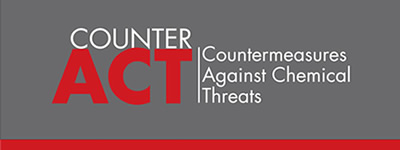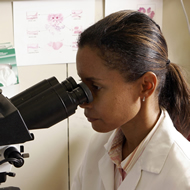
Environmental Factor, November 2008, National Institute of Environmental Health Sciences
Extramural Update
November 2008

NIEHS Expands Role in CounterAct Program
As part of its role in the NIH Countermeasures Against Chemical Threats (CounterACT) program (http://www.ninds.nih.gov/funding/research/counterterrorism/counterACT_home.htm")![]() , NIEHS will provide oversight of one new Research Center of Excellence at the University of Alabama at Birmingham (UAB) and one project at Duke University created this summer to develop therapeutics for chlorine-induced pulmonary damage. These awards augment the existing NIEHS portfolio within the NIH CounterACT program to develop therapeutics for lung injury induced by chemical threats such as chlorine, sulfur mustard, sarin, phosgene and acrolein.
, NIEHS will provide oversight of one new Research Center of Excellence at the University of Alabama at Birmingham (UAB) and one project at Duke University created this summer to develop therapeutics for chlorine-induced pulmonary damage. These awards augment the existing NIEHS portfolio within the NIH CounterACT program to develop therapeutics for lung injury induced by chemical threats such as chlorine, sulfur mustard, sarin, phosgene and acrolein.
Sadis Matalon, Ph.D., a professor and the director of research in the Division of Critical Care and Perioperative Medicine at the UAB School of Medicine, will direct the Center (http://138.26.50.19/)![]() . The Center represents a collaboration between UAB and Yale University in New Haven, Conn.
. The Center represents a collaboration between UAB and Yale University in New Haven, Conn.
Duke University Professor Michael Gunn, M.D. (http://humanvaccine.duke.edu/modules/gunn/index.php?id=1)![]() , is the principle investigator of the newly awarded research project, titled "Prevention of Inflammatory Lung Injury after Chlorine Exposure." Gunn is director of the Laboratory of Dendritic Cell Biology in the Duke Human Vaccine Institute.
, is the principle investigator of the newly awarded research project, titled "Prevention of Inflammatory Lung Injury after Chlorine Exposure." Gunn is director of the Laboratory of Dendritic Cell Biology in the Duke Human Vaccine Institute.
As a result of solicitations for proposals for the CounterAct Research Network in 2006, NIH funded four Centers of Excellence, 24 individual research projects, six Small Business Innovation Research (SBIR) awards, two contracts and four interagency agreements with Department of Defense (DoD) laboratories. NIH was able to add two more Centers and seven new individual research projects in 2008.
NIEHS provides oversight of those CounterACT awards that focus primarily on pulmonary injury including two Centers of Excellence and six individual research projects. These projects are developing therapeutic agents against sarin, sulfur mustard, chlorine, phosgene, diphosgene, triphosgene, ammonia, acrolein, half mustard, 2-chloroacetophenone and sulfuric acid. While DoD has had an ongoing research program related to chemical threats, its interests are restricted to military populations. The NIH research agenda, for its part, includes the demographic diversity of the nation's civilian population. Sharing of information and resources among CounterACT investigators is facilitated by scientific interest groups that communicate frequently, as well as by annual symposiums of the entire Network.
With the attacks on the United States in 2001, the growing threat of terrorism has become a national security priority. In response to both the terrorist attacks and the anthrax scare that followed six weeks later, DHHS, through many NIH partners, developed a research agenda focused on meeting the needs of the civilian population in the event of a biological, radiological or chemical attack on our nation. Many of the same chemicals posing a threat as terrorist agents may also be released from transportation and storage facilities because of industrial accidents or natural disasters.
In addition to NIEHS, the CounterAct Research Network includes the National Institute of Allergy and Infectious Diseases (NIAID), National Institute of Neurological Disorders and Stroke (NINDS), National Eye Institute (NEI), National Institute of Arthritis and Musculoskeletal and Skin Diseases (NIAMS), Eunice Kennedy Shriver National Institute of Child Health and Human Development (NICHD), and National Institute of General Medical Sciences (NIGMS). The overall goal of the CounterACT program is the development of new and improved medical countermeasures designed to prevent, diagnose and treat the conditions caused by potential and existing chemical threat agents.
For more information regarding the CounterACT Research Network, see: www.ninds.nih.gov/counteract (http://www.ninds.nih.gov/counteract)![]() .
.
Contacts: NIEHS: Elizabeth A. Maull, Ph.D., program administrator | maull@niehs.nih.gov NINDS: David A. Jett, Ph.D., lead program director for the NIH CounterAct program jettd@ninds.nih.gov
CounterAct - A Collaborative Research Agenda
The funding opportunity announcements establishing the Network identified four groups of high priority chemical threats:
- Neurotoxic agents, such as organophosphorus nerve “gases”
- Vesicating agents, for example sulfur and mustard
- Pulmonary agents, such as chlorine gas
- Metabolic/cellular poisons, such as cyanide
Proposed research projects fell into five categories:
- Mechanistic research to identify targets for therapeutic/diagnostic development
- Development of in vitro and animal models for efficacy screening of therapeutic and diagnostic tools
- Efficacy screening of therapeutics/diagnostics using appropriate new and validated in vitro and animal models
- Advanced efficacy studies with appropriate animal models including non-human primates
- Clinical studies, including trials, when appropriate.
"Superfund Study Detects......" - previous story ![]()
![]() next story - "Extramural Papers......"
next story - "Extramural Papers......"
November 2008 Cover Page



